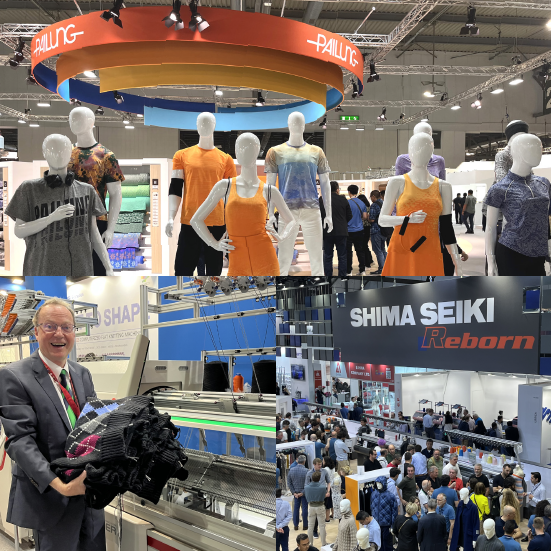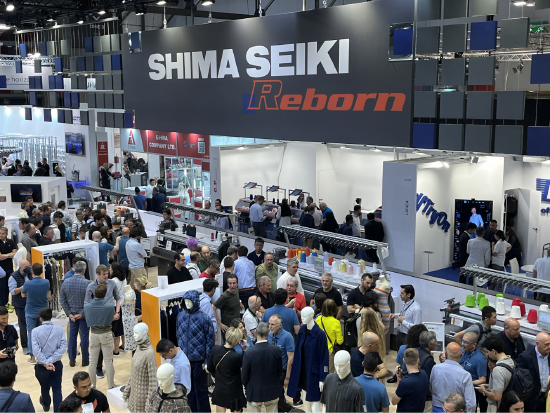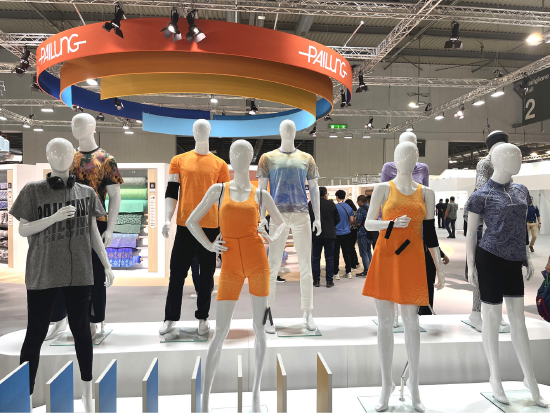16 22
September 2027
Messegelaende HannoverGermany

Purely incremental improvements to the mechanical performance of weaving and knitting machines are only to be expected, given their long history. Only occasionally, do game-changing technologies come along, and Wholegarment seamless knitting pioneered by Japan’s Shima Seiki was undoubtedly one of them.
That was 20 years ago now, but digital automation continues to offer new possibilities for advanced fabrics produced with the technology. Here at ITMA, Shima Seiki is demonstrating no less than nine flat knitting machines in its new R-Series range, including shaping and glove-knitting machines, with many new features.
More than 300 sophisticated fabric samples are also being showcased at the company’s stand, ranging from fashion, sports, shoes, bags and accessories to medical, safety, automotive and wearables.
In addition, the company’s Apex series graphic design system has been upgraded with significant improvements for knit programming, 3D functionality, speed and ease of use, making significant improvements in realistic virtual sampling possible, supported by full digital solutions and integrated web services.

Wholegarment seamless knitting pioneer Shima Seiki’s packed stand.
Another flat knitting machine manufacturer, Switzerland’s Steiger is introducing the new Antares flat knitting machine for the production of coarse gauge intarsia sweaters.
Steiger employs a special position in the knitting machinery industry, with 70% of its turnover generated from the sales of unique machines, interfaces and services to the medical sector for the production of customised orthopaedic compression supports. Via connected body scanners, these products are supplied to medical professionals within 24 hours of being ordered.
“Knitted electrodes and sensors, as well as reinforcement supports for composites, are also smaller but growing areas where Steiger machines are employed,” said sales manager Carlo Corradi.
Specialised intarsia machines for high quality and complex knitwear are meanwhile designed for the suppliers to leading luxury brands including Burberry, Chanel, Dior, Hugo Boss and Versace.
The new Steiger Antares 2.185 has 24 yarn guides to make coarse gauge (three needles per inch) intarsia sweaters. It can handle panels, fully fashioned, shaped garments, Jacquard and stitch structure combinations and has the characteristic Steiger open carriage with two knitting systems allowing, a full three-way-technique, with variable intelligent stroke knitting on a 185cm needlebed.

Steiger sales manager Carlo Corradi displaying some knitted fabrics.
Taiwan’s Pailung, a leading manufacturer of circular knitting machines is meanwhile introducing AlterKnit, its latest fabric technology.
AlterKnit enables textile designers and manufacturers to produce luxurious fabrics with intricate patterns knitted into their structure while eliminating any need for fabric printing or dyeing,” explained chairman and CEO James C.C. Wang. “The upgraded version of inverse plating enables alternate yarns of different colour or composition to be knitted together within the same row.”
The technology yields crisp patterns with sharp borders and is a noticeable step up from standard inverse plating. It can capture the intricate details of a sports team emblem, for example, including text and logos. It is also reversible, producing two inverted versions of the same design in up to four colours on either side.
When designing for sportswear, different types of yarn can be combined to create functional fabrics with enhanced features, such as moisture-wicking, breathability, elasticity etc.
Unlike traditional printing, the designs produced on AlterKnit fabrics are knitted into the fabric’s structure, preventing any chemicals used during production from rubbing off or leaking into the surrounding environment.
The AlterKnit process can also reduce waste during production. In certain techniques like intarsia, yarns of different colours are knitted together, causing strands of loose yarn – yarn floats – to run along the back of the fabric.
With AlterKnit and the inverse plating technique, both the front and back of the fabric display patterns that mirror each other, which means there are no yarn floats to trim away.

Advanced fabric constructions showcased by Pailung.
It goes without saying that these advanced developments are just the tip of the iceberg here at ITMA 2023.
Subscribe to our mailing list and stay up-to-date with news and developments in ITMA and the textile and garment industry.